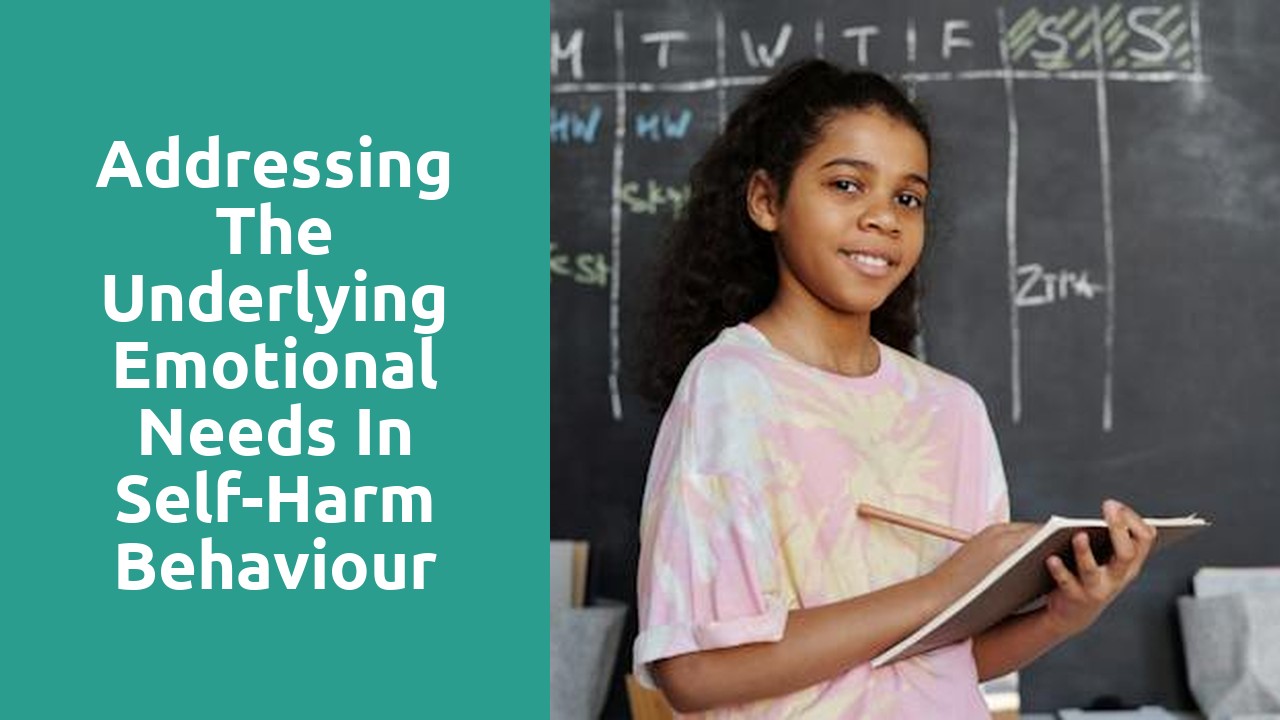

Self-harm behavior in individuals with Social, Emotional and Mental Health (SEMH) challenges is a complex issue that requires a deep understanding of the emotional causes behind it. Many factors can contribute to the onset and maintenance of self-harming behaviors, including a lack of emotional regulation skills, unresolved trauma, and difficulty expressing emotions effectively. For those struggling with SEMH, self-harm may serve as a way to cope with intense emotional pain or to gain a sense of control when feeling overwhelmed by their emotions. By delving into the underlying emotional causes of self-harm, we can gain insight into the individual's internal struggles and develop meaningful interventions that address their emotional needs.
To better comprehend the emotional causes of self-harm behavior in SEMH, it is crucial to consider the impact of adverse childhood experiences (ACEs) and traumatic events. Many individuals who engage in self-harm have experienced significant trauma in their lives, such as abuse, neglect, or witnessing violence. These traumatic experiences can disrupt normal emotional development and result in difficulties processing and regulating emotions. Consequently, self-harm may become a maladaptive coping mechanism for individuals with SEMH, as it provides temporary relief from emotional pain or a tangible outlet for pent-up feelings. Understanding these emotional causes is fundamental in designing effective strategies to support individuals in their journey towards emotional healing and well-being.
Self-harm behavior in SEMH (Social, Emotional, and Mental Health) individuals is often a complex and multifaceted issue that requires a deeper understanding of the hidden triggers behind it. While the causes may vary from person to person, it is crucial to recognize the emotional factors that contribute to self-harm in order to provide appropriate support and intervention.
One of the hidden triggers behind self-harm in SEMH is intense emotional pain. When individuals are unable to cope with overwhelming emotions such as anger, sadness, or despair, they may turn to self-harm as a way to release or distract from their emotional distress. The physical pain inflicted through self-harm can serve as a temporary escape or momentary relief from emotional turmoil. Understanding this underlying connection between emotional pain and self-harm is essential in developing effective strategies to address the root causes and help individuals find healthier coping mechanisms.
Self-harm behavior is often deeply rooted in the unmet emotional needs of individuals with Social, Emotional, and Mental Health (SEMH) difficulties. Understanding the connection between emotional needs and self-harm is crucial in order to provide effective support and intervention strategies. These emotional needs can vary greatly among individuals, but often encompass feelings of isolation, low self-esteem, loneliness, and an overwhelming sense of emotional distress.
One aspect of exploring the connection between emotional needs and self-harm is recognizing the importance of validation and empathy. Many individuals engaging in self-harming behaviors are seeking a way to cope with intense emotions that they may struggle to express verbally. By offering a safe and non-judgmental space for individuals to share their feelings, we can begin to address the underlying emotional needs fueling self-harm behaviors. This validation and empathy helps to reduce feelings of isolation and provides individuals with a sense of emotional support that is often lacking in their lives.
Self-harm behavior in individuals with SEMH can be a distressing and complex issue to address. However, there are strategies that can be implemented to support their emotional well-being and help them overcome this harmful behavior. One key aspect is the provision of a safe and supportive environment. Establishing a trusting relationship between the individual and caregivers or professionals is crucial in order to create an atmosphere where they feel comfortable opening up and seeking help.
In addition to a safe environment, it is important to provide individuals with SEMH with the necessary coping skills to manage their emotions effectively. Teaching them healthy ways to express their feelings such as through art, writing, or engaging in physical activities can serve as positive outlets for their emotions. Encouraging self-reflection and the development of emotional intelligence can empower them to recognize triggers and develop alternative ways to deal with stressors. Individualized therapy sessions such as cognitive-behavioral therapy (CBT) or dialectical behavior therapy (DBT) can also be effective in equipping them with the necessary tools to cope with emotional distress.
Self-harm behavior in individuals with social, emotional, and mental health (SEMH) difficulties can be a complex and distressing issue. It is crucial to understand that self-harm is often a result of deep emotional pain and an attempt to gain some sense of control or relief from overwhelming emotions. Therefore, empowering emotional resilience is vital in reducing self-harm in SEMH.
One effective strategy for empowering emotional resilience is to promote self-awareness and emotional regulation skills. Encouraging individuals to identify and express their feelings in a safe and non-judgmental environment can help them develop a better understanding of their emotions. This, in turn, enables them to recognize their emotional triggers and learn healthier ways to cope with distress. Additionally, teaching and practicing techniques such as deep breathing, mindfulness, and grounding exercises can provide individuals with practical tools to manage their emotions effectively. By fostering emotional resilience, individuals with SEMH can build the strength and skills needed to reduce self-harm behaviors and navigate their emotional struggles in a more adaptive and healthy manner.
Creating a supportive environment for emotional healing is essential for individuals with self-harm behavior in SEMH. It is crucial to establish a safe and non-judgmental space where these individuals can express their emotions freely without fear of criticism or misunderstanding. Building trust and fostering open communication are key components of such an environment.
One way to foster emotional healing is by providing individuals with the opportunity to engage in meaningful and constructive activities. Encouraging participation in art therapy, sports, or other creative outlets can help individuals express and process their emotions in a healthy and productive manner. Additionally, providing a variety of support resources, such as counseling services, support groups, and peer mentors, can further contribute to a supportive environment that promotes emotional well-being and reduces the likelihood of self-harm behavior.